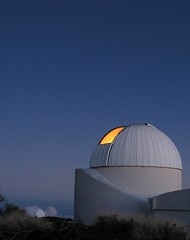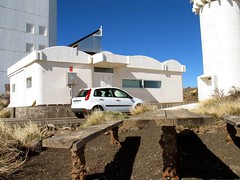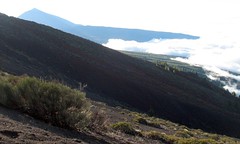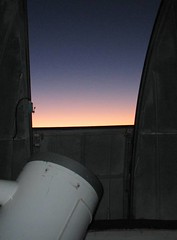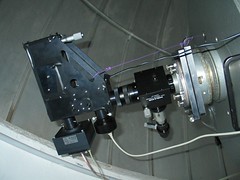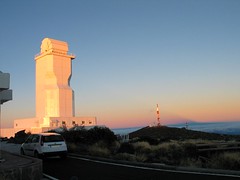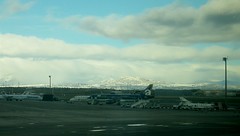Flatfields, flats, dark frames, darks, biases, neons..
These words you have read quite a few times on my posts, and will likely continue to read.. These are necessary images we have to do. They are of specific things, and in a way they are always the same.. So why not make one and use it forever?
The answer to this question makes it clear that some of these images really must be "repeated".
CCDs are noise accumulation devices, that also have this side-effect of accumulating interesting signal. But since both things are accumulated together, there is no clear way to separate them. However, you can do several things that help: You can ask the CCD several times what it is seeing and then average that (this is why several images are usually taken). But since the noise is still there, you may want to ask the CCD what it sees with his eyes closed! This is an apparently stupid question to ask a CCD, but if we think a bit we will understand that in this case we know for certain what the CCD is seeing: nothing!
So if the CCD is seeing nothing, and it says it saw something, you know how much of what it says is a lie. Since CCDs are usually not very imaginative, you can assume the lie is always of the same amount. This allows you to subtract (callibrate) all your measurements by this amount of lies and uncertainty.
Well of course there are different kinds of lies.. there are those that happen because you asked the question, and those that keep getting more complex as time goes by. Therefore you need different kinds of measurements.
Biases are those used to determine the uncertainty due to only reading the CCD. And
Dark Frames ("
darks" for short) are measurements for what nonsense has been accumulating during the time of an exposure.
Now imagine you want to measure the length of something but the ruler that is given to you has no zero marked on it. How can you possibly measure this? Well, you can't!.. With a single measurement, at least. You must take two measurements, and subtract both, to get a "distance".
In spectroscopy, the same happens. You take an image, convert it to a "unidimensional graph", and now somewhere on that jagged graph is supposed to be an emission line of H-alpha, that we have learned to be "precisely" on 656.281 nanometers. This is just like that joke about mathematicians: what I have said so far is correct, but arguably useful, because we don't know where in the graph that frequency must be. This is were the "
neon calibration images" come in! This second measurement of something absolutely stupid like an unintelligent neon light bulb, that you don't find on stores often, is the key to knowing where some emission lines are.
So if you don't touch anything on the telescope after you have taken the measurement of the target star, and immediately after that you take an exposure of a neon light, you can assume that the position of the neon emission lines are the same as if the star also emitted them. So is to say that if a line of the neon spectrum appears at pixel x=342, and if you see something on your star's spectra 5 pixels to the left of that, than you can calculate the difference in wavelegth.
Imagine now that you are using spectacles. Better yet, imagine you haven't cleaned them for two months! Or imagine that your eye is less sensitive to blue than to green (like most people). How can you possibly measure the amount of light of a given color that is independant of glasses used, or eye sensitivity? Simple: you look at what you are measuring, and then look at a white wall thing that fills your view; next you divide what you saw the first time by the whitish stuff. So if there was a stain in the glasses that darkened what you saw, it also darkened the white color. Again white is something you know what it is, so a darkened white can be measured as white if you divide it by itslef. If you divinde
A by
B and get the right thing that you wanted to measure (even if
A =
B) then you know that what ever you measure must also be devided by that
B. You must, of course, try to guarantee the B stays very much away from zero, as that would allow you to measure infinity.....
A/0?
That
B is called
flatfield image, or
flat for friends.
Some of these things stay rather constant with time: biases and darks, if temperature is constant, or flatfields if you have not changed the grating position on the spectrograph, or even neon lines if the spectrograph has not moved much so that gravity pulls on internal spectrograph parts differently. As soon as any of those parameters change, new respective calibration images need to be made.
Every night we are supposed to change grating position once, so we need two flatfields per night. We are also pointing at different targets so we need two neon frames per target. Luckily our CCD camera is cooled to a controlled temperature, so we don't need those many dark and bias frames..
Some of these calibration images can be made during the day (flatfields, darks, biases), which occupies some daylight time, and frees other in the nighttime. The normal day-to-day routine in an observatory is doing this, and managing all other stuff like conciliating sleep times with meal times or other services that are only available on specific hours.. In the end, weather spoils the routine more than the data.
 The bad weather from yesterday is not over yet. Forecasts say weather will improve starting tomorrow. Tomorrow is New Year's Eve, and we must go down to a hotel at Puerto de la Cruz again, because the observatory will close once more for the holiday. We will again stay there for two nights, coming back on the 2nd of January. We will not have internet connection then.
The bad weather from yesterday is not over yet. Forecasts say weather will improve starting tomorrow. Tomorrow is New Year's Eve, and we must go down to a hotel at Puerto de la Cruz again, because the observatory will close once more for the holiday. We will again stay there for two nights, coming back on the 2nd of January. We will not have internet connection then.







